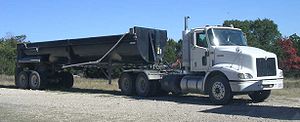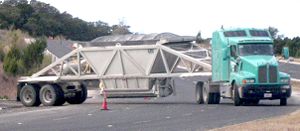An asphalt plant is a plant used for the manufacture of asphalt, macadam and other forms of coated roadstone, sometimes collectively known as blacktop.
The manufacture of coated roadstone demands the combination of a number of aggregates, sand and a filler (such as stone dust), in the correct proportions, heated, and finally coated with a binder, usually bitumen based or, in some cases, tar. The temperature of the finished product must be sufficient to be workable after transport to the final destination. A temperature in the range of 100 - 200 degrees Celsius is normal.
Increasingly, recycled asphalt pavement (RAP) is used as part of the mix. The binder used is flammable, and the heaters are large liquid or gas fired burners. RAP is introduced after the heating process and must be accounted for in the overall mix temperature calcualtions.
There are three main classes of plant: batch heater, semi-continuous (or "asphalt plant"), and continuous (or "drum mix"). The batch heater has the lowest throughput, the continuous plant the highest at up to around 500 Tonnes per hour.
Supply of roadstone for large contracts is generally by tender with considerable pressure on price. A faulty batch of roadstone must be planed up and relaid, often with additional lane rental charges, at a cost which may be orders of magnitude higher than the original price, so sophisticated control systems are a necessity.
Sand
One key ingredient of most roadstones is sand. Sand generally has a high water content. Boiling off this water is a large part of the energy cost of heating the aggregate, in turn a significant part of the overall cost of operation. The water content of sand also varies considerably, especially when stored outdoors, being typically of the order of some tens of percent of the overall mass of wet sand. Since sand takes the form of small grains, with a high surface area per unit volume, and binder attaches to the surface of the aggregates, the amount of dry sand in the mix is particularly critical to the overall blend; the moisture content must be measured and the equivalent dry weight calculated.
Binder
Binder comes in different grades known as "penetration" or "pen" grades, with values varying between around 30 and 300. The pen value is an expression of the depth to which a standard needle will penetrate the surface of the binder at a specified temperature (the higher the value, the softer the binder). This has an effect on the workability of hot asphalt and the stiffness of the asphalt when cooled. Lower pen values give harder wearing. Asphalt wearing courses are typically 35-50 pen, base courses will be higher, typically 200 or 300 pen. The coating plant may combine binder of different grades to achieve a grade between those held on site.
Filler
Filler, as the name implies, fills the voids between aggregate grains and improves the wearing capabilities of the overall mix. It is stored and fed dry into the mix, during or after addition of binder. A common source of filler is fines from the heating process recovered by bag filters or wet filtration ponds from the exhaust of the heating drum.
Types of plant
Batch heater
A batch heater plant weighs the raw aggregates into a heater drum, where the batch is then heated up to temperature. The hot aggregate is discharged into a mixing drum where (dry) filler and binder are added. The blend is mixed and discharged either directly into the delivery vehicles or into a small weighing and collecting hopper. To increase throughput, the heater can be heating the next batch while the previous is being mixed. Capacity is usually of the order of tens of tonnes per hour.
Batch heater plant is used where short production runs are common (a different recipe can be used on each mix) or where total volume is low. Mobile batch heaters are available.
Semi-continuous
The term "asphalt plant" strictly refers to a semi-continuous plant. Aggregates and sand are brought up from ground hoppers by continuous conveyor belt in approximate proportions, heated in a drum to dry them and bring them up to temperature, screened back into their respective sizes by diameter (e.g. sand, <10mm,>
Level sensors in the hoppers may be used to inform the aggregate feed rates to ensure that the level of each hot aggregate remains reasonably consistent.
Batch weighing and mixing allows for rapid changes of mix, but the time delay in heating and screening means that the overall balance of aggregates needs to be matched to the ovewrall feed, so this type of plant is less suitable for very short runs. Capacity is typically of the order of a few hundreds of tonnes per hour.
Continuous
In the continuous plant, raw aggregate is brought up from ground hoppers at a precisely controlled rate and fed into a heater drum similar to that used in the asphalt plant. Once heated it is immediately coated in the same drum (with the binder spraybars situated behind the burner) or in a smaller drum situated immediately behind it. Finished product is almost invariably discharged into a hot store rather than directly into delivery vehicles.
Changing mix is achieved by varying the feed rates of the aggregate, filler and binder feeders, with time delays so that the change of blend occurs at the same point in the coating drum. Sand tends to move more slowly through the heating drum, so the blend proportions will not necessarily change at the same point on the feed conveyor. It is common to divert a small amount of material to a waste chute when the transition point reaches the hot elevator.
Drum mix plants are not really suitable for short production runs; although with sophisticated controls the change of mix can be accurate to within some seconds, production rates of hundreds of tonnes per hour may equate to a tonne every ten seconds or so.
Hot storage
Finished roadstone must be kept heated to avoid setting. It is commonly stored in large electrically heated insulated stainless steel silos, from which it is weighed into delivery vehicles. This may be achieved by intermediate weigh hoppers (which may shuttle between hoppers) or by mounting the hoppers directly on load cells. Control of loadout by this method involves accurately predicting the material "in flight" between the discharge door and the vehicle.







